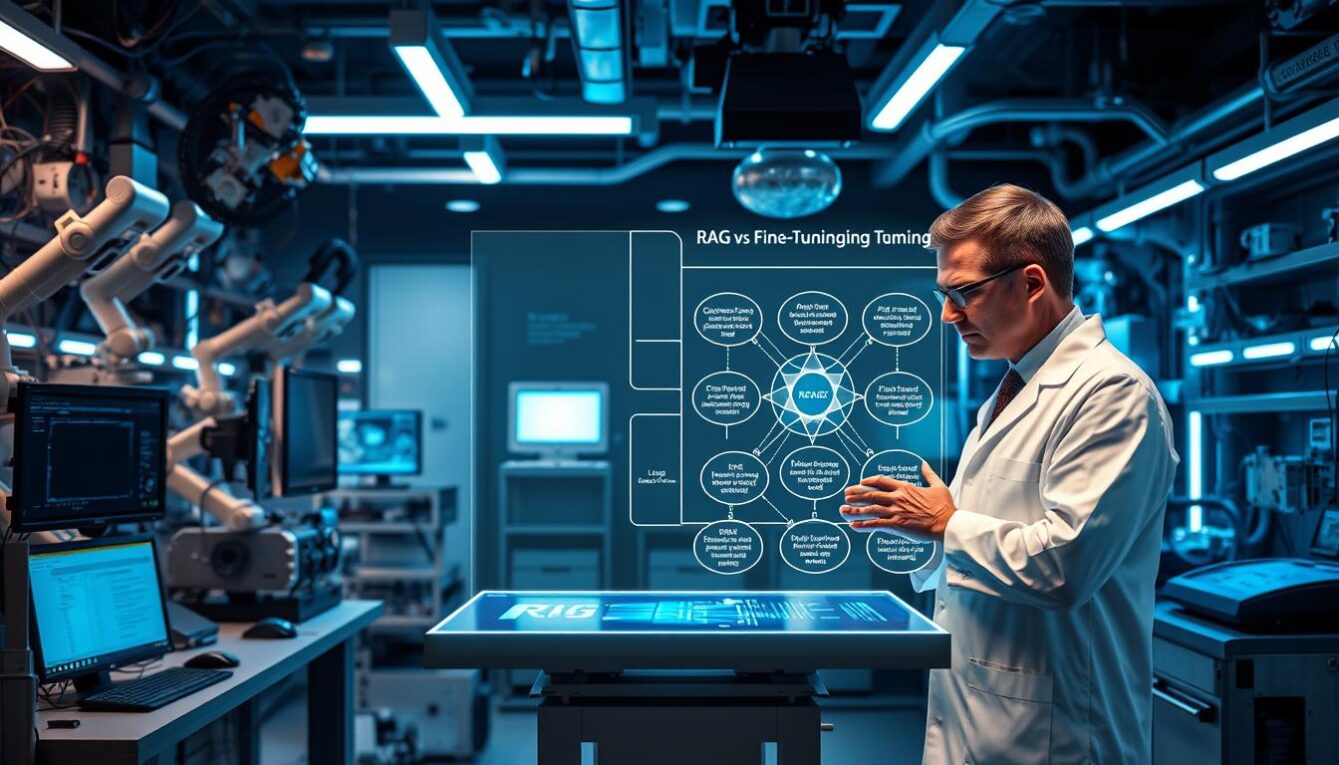Did you know large language models (LLMs) are changing how we do things in tech? They can handle lots of data. This makes them key for people wanting to work better.

I’ve worked hard on new ideas. I’m happy to talk about RAG and Fine-Tuning. These help make LLMs work better. This means better results and more work done.
Key Takeaways
- Understanding the basics of RAG and Fine-Tuning
- Learning how to apply these techniques to LLM Training
- Discovering the benefits of optimized language models
- Exploring real-world examples of RAG and Fine-Tuning in action
- Improving workflow efficiency with enhanced LLMs
Introduction to RAG and Fine-Tuning
In the world of LLMs, RAG and fine-tuning are big deals. They change how we train language models. These ideas make LLMs better and more flexible.
What is RAG?
RAG is a big step forward in natural language processing. It mixes two ways to get better answers. This way, RAG models give more relevant info, making text better.
The Importance of Fine-Tuning in LLMs
Fine-tuning is key for LLMs. It makes pre-trained models work better for specific tasks. This makes them more accurate and saves time.
It’s great for learning about special words and ideas. Fine-tuning helps models understand these better. This makes their answers more right and relevant.
Key Terms and Concepts
To get RAG and fine-tuning, we need to know some important words. These include:
- Parameter-Efficient Fine-Tuning: Ways to make pre-trained models work well with few changes.
- Retrieval-Augmented Generation: A method that mixes getting and making info to give better answers.
- LLM Training: Training big language models on lots of data to make them write like humans.
| Concept | Description | Benefits |
|---|---|---|
| RAG | Combines retrieval and generation approaches | More accurate and informative responses |
| Fine-Tuning | Adapts pre-trained models to specific tasks | Improved performance, reduced training times |
| Parameter-Efficient Fine-Tuning | Minimizes parameter updates during fine-tuning | Efficient adaptation, reduced computational costs |
Understanding Retrieval-Augmented Generation (RAG)
Learning about Retrieval-Augmented Generation (RAG) is key to improving language models. It changes how we work with natural language. RAG is making big waves in this field.
RAG is more than just a small update. It’s a big step up for language models. It adds a new way to make models better at answering questions.
How RAG Transforms Language Models
RAG changes language models by adding a new part. This part lets the model find and use information outside its training. This makes the model’s answers more accurate and up-to-date.
This new way of working is a big deal in LLM Training. RAG models can now give more detailed answers. This makes them more useful in real life.
Core Components of RAG
RAG has two main parts: the retriever and the generator. The retriever module finds important info. The generator module uses this info to create answers.
- The retriever uses a special kind of search to find the right info.
- The generator, based on transformers, makes answers that fit the context.
Benefits of Using RAG
Using RAG has many advantages. It helps models give better answers by using outside knowledge. This is especially helpful when just training the model isn’t enough.
RAG also needs less training data. It can find info on its own, not just from what it was trained on. This makes RAG very useful for LLM Training and using in real situations.
The Fine-Tuning Process Explained
To get LLMs to work their best, we need to understand fine-tuning. It’s a key step that lets these models learn new tasks and improve their skills.
Overview of Fine-Tuning
Fine-tuning means tweaking a pre-trained model for a new task. It uses the model’s old knowledge and makes it fit the new task better. Parameter-Efficient Fine-Tuning is popular because it works well with fewer changes.
First, we pick a good pre-trained model. We choose based on the task’s needs. Then, we get the data ready for fine-tuning. This includes cleaning and adding more data to make the model stronger.
Types of Fine-Tuning Techniques
There are many fine-tuning methods, each with its own strengths. Transfer learning is common. It uses a big model trained on lots of data and fine-tunes it for a smaller task. This works well when data is limited.
- Full Fine-Tuning: Updates all model parts.
- Partial Fine-Tuning: Only updates some parts.
- Parameter-Efficient Fine-Tuning: Uses adapters and prompt tuning to update fewer parameters.
Challenges in Fine-Tuning Models
Fine-tuning has its own problems. One big issue is overfitting. The model gets too good at the fine-tuning data and can’t generalize well. Another problem is the cost of fine-tuning big models.
To solve these issues, we use tricks like regularization and early stopping. Choosing the right fine-tuning method and watching the model’s performance helps too.
Setting Up Your Environment for Fine-Tuning
Fine-tuning a language model needs a good setup. I’ll show you how to do it. First, you need to know what makes up this setup.
Required Tools and Libraries
First, install the tools and libraries you need. For LLM Training and fine-tuning, you’ll need:
- Python as your main programming language
- Deep learning frameworks like TensorFlow or PyTorch
- Libraries like Hugging Face’s Transformers for pre-trained models
- More stuff based on your project
Make sure your tools are up to date. This helps you use the latest Fine-Tuning methods.
Configuring Your Workspace
After getting your tools, set up your workspace. This means:
- Choosing a code editor or IDE for Python and deep learning
- Organizing your project well for easy work
- Using Git for tracking changes and team work
A neat workspace makes Fine-Tuning easier. It helps you try new things and improve.
Setting Hardware Requirements
Fine-tuning big language models needs strong hardware. Important things include:
- A good GPU (or many GPUs) for lots of work
- Enough RAM for big data and models
- Enough space for your data, models, and files
If you don’t have top-notch hardware, cloud services like AWS or Google Cloud are good. They offer scalable help for LLM Training and fine-tuning.
With the right tools, setup, and hardware, you’re ready for fine-tuning. You can use RAG and other advanced methods well.
Data Preparation for Fine-Tuning
Data preparation is key in LLM training. It has many steps that affect how well the model works. These steps are important for the model’s success.
Selecting the Right Dataset
Choosing the right dataset is the first step. It should match the task and be like real-world data. A good dataset makes the model better and less biased.
For example, if you want to fine-tune for healthcare, use texts from that field. This makes the model more accurate.
Andrew Ng, a famous AI expert, said,
“Data is the new oil, and it’s not just about having data, it’s about having the right data.”
This shows how important the right dataset is.
Data Cleaning and Formatting
After picking a dataset, clean and format the data. This means removing bad info, fixing missing data, and making it all the same. Clean data makes the model learn better and be more accurate.
Balancing Your Training Data
It’s important to balance the data to avoid bias. You can do this by adding more of the less common data. This makes the model fairer and stronger.
For example, if one class has way more data, the model might favor it. Balancing the data fixes this problem. This way, the model’s predictions are fairer.
Implementing RAG in Your Workflow
Let’s explore how to use Retrieval-Augmented Generation (RAG) in your work. Adding RAG to your workflow can make your language models better and faster.
Integrating RAG with Existing Systems
To add RAG to your systems, plan carefully. First, find where RAG can help most. This might be in making your language models more accurate or in getting better information.
Key Steps for Integration:
- Look at your current setup and see where RAG can fit.
- Pick the right RAG model for your needs.
- Make a plan for using RAG, thinking about privacy and how it works with your systems.
Experts say adding RAG to your workflow can really improve how you work and make decisions.
“The integration of RAG into our workflow has been a game-changer, enabling us to process complex queries with unprecedented accuracy.”
Workflow Automation with RAG
RAG can also help automate your workflow. It can make tasks easier and help you make better decisions.
Benefits of Workflow Automation with RAG:
- Less need for humans, which means more work done.
- Tasks done more accurately, with fewer mistakes.
- Your business can grow without getting too busy.
Case Studies of RAG Implementation
Many companies have used RAG and seen great results. For example, a big tech company used RAG in their customer service. They solved 30% more questions correctly.
| Industry | Application | Outcome |
|---|---|---|
| Customer Service | RAG Integration | 30% Increase in Query Resolution Accuracy |
| Healthcare | Medical Research | Enhanced Data Retrieval Efficiency |
| Finance | Risk Analysis | Improved Predictive Modeling |
These examples show RAG’s value in different fields, like customer service, healthcare, and finance.
Evaluating Model Performance
In LLM training, checking how well a model works is very important. It’s key to making the model better. This process looks at many things to see if the model is good and reliable.
Metrics for Success
To see how well a model does, we look at different things. Accuracy is one, but there’s more. precision, recall, and F1 score give a full picture, especially with tricky data.
In tasks like classifying things, accuracy shows how often the model gets it right. But precision and recall tell us more about how it does with certain things. The F1 score is a mix of these, showing how well the model does in both areas.
Common Pitfalls in Evaluation
But, there are traps to watch out for. One is overfitting, where the model does great on some data but not others. Another is underfitting, where it misses the point of the data.
To skip these traps, we use tricks like cross-validation. We also check how the model does on new data to make sure it’s ready for real use.
Fine-Tuning Feedback Loop
A big part of checking a model is using a fine-tuning feedback loop. This means using what we learn to make the model even better. By tweaking the model a bit at a time, we can make it work much better.
This loop is key to Parameter-Efficient Fine-Tuning. It lets us make small changes that help a lot, without having to start over from scratch.
Best Practices for Efficient Fine-Tuning
Efficient fine-tuning needs good planning, smart training, and checking the model. To get the most from large language models, use a full plan. This plan should tackle fine-tuning’s special challenges.
Strategy and Planning
First, make a clear plan for fine-tuning. Pick the right model, find the best dataset, and set your goals.
- Know what you want to achieve with fine-tuning.
- Pick a model that fits your needs.
- Get a dataset that shows what you’re doing.
Optimizing Training Time
Shortening training time is key for fast fine-tuning. Use transfer learning and gradient checkpointing to save resources.
- Use transfer learning to start with a good base.
- Try gradient checkpointing to use less memory.
- Change batch sizes and learning rates for better results.
Avoiding Overfitting
Overfitting is a big problem in fine-tuning LLMs. Use regularization and early stopping to fight it.
- Regularization helps keep the model simple.
- Early stopping stops training when it starts to get worse.
- Watch how the model does to catch overfitting early.
Advanced Techniques in Fine-Tuning
Exploring advanced techniques in fine-tuning is key. These methods boost your LLM training’s performance. They make training more efficient and effective.
Transfer Learning Approaches
Transfer learning is a strong method in fine-tuning. It lets models use pre-trained knowledge for new tasks. This cuts down training time and boosts model performance.
Key Benefits of Transfer Learning:
- Reduced training time
- Improved model performance
- Adaptability to new tasks
Parameter Tuning Methods
Parameter tuning is vital for fine-tuned models. You can use grid search, random search, and Bayesian optimization. These find the best hyperparameters.
| Tuning Method | Description | Advantages |
|---|---|---|
| Grid Search | Exhaustive search through a manually specified subset of hyperparameters | Thorough exploration of hyperparameter space |
| Random Search | Random sampling of hyperparameters within specified bounds | Efficient for large hyperparameter spaces |
| Bayesian Optimization | Probabilistic search for optimal hyperparameters using a surrogate model | Balances exploration and exploitation efficiently |
Leveraging Ensemble Models
Ensemble models combine predictions for better performance. They reduce overfitting and improve generalizability. This makes your fine-tuned models more reliable.
Using these advanced techniques in your fine-tuning workflow boosts accuracy. It advances your LLM training capabilities.
Future Trends in LLM Training
The future of LLM training will blend RAG, fine-tuning, and AI rules. We must keep up with new trends in this field. This will help us explore what’s possible with large language models.

Evolving Technologies in RAG and Fine-Tuning
Technologies in RAG and fine-tuning are changing fast. New methods are being found to make LLM training better. One big step is mixing RAG with other AI, like reinforcement learning.
Also, fine-tuning is getting smarter. New ways to tweak LLMs for specific tasks are being found. These updates will help LLMs work better in real life.
Predictions for Industry Changes
Many industries will use RAG and fine-tuning more in the future. These tools will become easier to use. This means we’ll see them in customer service, healthcare, and education more often.
Another big change is making AI models easier to understand. As LLMs get used more, we’ll need to know how they work. This will lead to models that are clearer to see.
The Role of AI Regulations
AI rules will shape LLM training’s future. They will make sure these technologies are used right. Rules will balance new ideas with keeping users safe.
Companies working with LLMs must keep up with these rules. They need to follow new guidelines and help make standards. This way, they can use LLMs responsibly and safely.
Conclusion: Embracing RAG and Fine-Tuning
RAG and Fine-Tuning are key in making LLM Training better. They help our models work more accurately and quickly. By using these methods, we can make our models much better.
Key Takeaways
This guide shows how important RAG and Fine-Tuning are. RAG adds extra knowledge to language models. Fine-Tuning makes models better for specific tasks. Parameter-Efficient Fine-Tuning is especially good at saving resources.
Resources for Further Learning
If you want to learn more, check out the latest LLM Training research papers. Try out different Fine-Tuning methods, like Parameter-Efficient Fine-Tuning.
Final Thoughts on LLM Advancements
RAG and Fine-Tuning will keep being important for LLM Training’s future. By using these technologies and keeping up with new info, we can explore new things. This will help us innovate more in the field.










